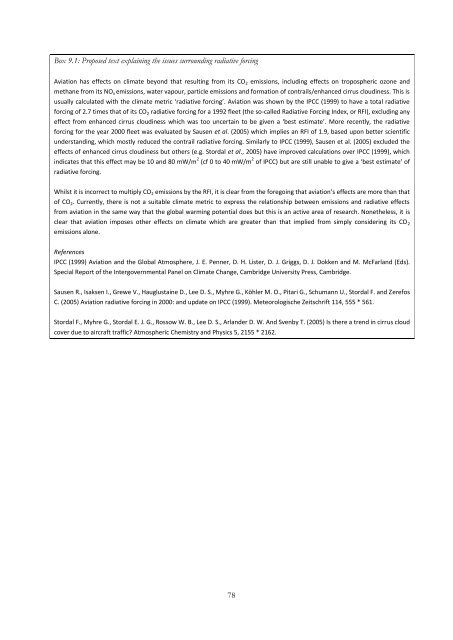Methodology for assessing carbon footprints of horticultural products
Methodology for assessing carbon footprints of horticultural products
Methodology for assessing carbon footprints of horticultural products
You also want an ePaper? Increase the reach of your titles
YUMPU automatically turns print PDFs into web optimized ePapers that Google loves.
Box 9.1: Proposed text explaining the issues surrounding radiative <strong>for</strong>cing<br />
Aviation has effects on climate beyond that resulting from its CO 2 emissions, including effects on tropospheric ozone and<br />
methane from its NO x emissions, water vapour, particle emissions and <strong>for</strong>mation <strong>of</strong> contrails/enhanced cirrus cloudiness. This is<br />
usually calculated with the climate metric ‘radiative <strong>for</strong>cing’. Aviation was shown by the IPCC (1999) to have a total radiative<br />
<strong>for</strong>cing <strong>of</strong> 2.7 times that <strong>of</strong> its CO2 radiative <strong>for</strong>cing <strong>for</strong> a 1992 fleet (the so-called Radiative Forcing Index, or RFI), excluding any<br />
effect from enhanced cirrus cloudiness which was too uncertain to be given a ‘best estimate’. More recently, the radiative<br />
<strong>for</strong>cing <strong>for</strong> the year 2000 fleet was evaluated by Sausen et al. (2005) which implies an RFI <strong>of</strong> 1.9, based upon better scientific<br />
understanding, which mostly reduced the contrail radiative <strong>for</strong>cing. Similarly to IPCC (1999), Sausen et al. (2005) excluded the<br />
effects <strong>of</strong> enhanced cirrus cloudiness but others (e.g. Stordal et al., 2005) have improved calculations over IPCC (1999), which<br />
indicates that this effect may be 10 and 80 mW/m 2 (cf 0 to 40 mW/m 2 <strong>of</strong> IPCC) but are still unable to give a ‘best estimate’ <strong>of</strong><br />
radiative <strong>for</strong>cing.<br />
Whilst it is incorrect to multiply CO 2 emissions by the RFI, it is clear from the <strong>for</strong>egoing that aviation’s effects are more than that<br />
<strong>of</strong> CO 2. Currently, there is not a suitable climate metric to express the relationship between emissions and radiative effects<br />
from aviation in the same way that the global warming potential does but this is an active area <strong>of</strong> research. Nonetheless, it is<br />
clear that aviation imposes other effects on climate which are greater than that implied from simply considering its CO 2<br />
emissions alone.<br />
References<br />
IPCC (1999) Aviation and the Global Atmosphere, J. E. Penner, D. H. Lister, D. J. Griggs, D. J. Dokken and M. McFarland (Eds).<br />
Special Report <strong>of</strong> the Intergovernmental Panel on Climate Change, Cambridge University Press, Cambridge.<br />
Sausen R., Isaksen I., Grewe V., Hauglustaine D., Lee D. S., Myhre G., Köhler M. O., Pitari G., Schumann U., Stordal F. and Zerefos<br />
C. (2005) Aviation radiative <strong>for</strong>cing in 2000: and update on IPCC (1999). Meteorologische Zeitschrift 114, 555 * 561.<br />
Stordal F., Myhre G., Stordal E. J. G., Rossow W. B., Lee D. S., Arlander D. W. And Svenby T. (2005) Is there a trend in cirrus cloud<br />
cover due to aircraft traffic? Atmospheric Chemistry and Physics 5, 2155 * 2162.<br />
78


